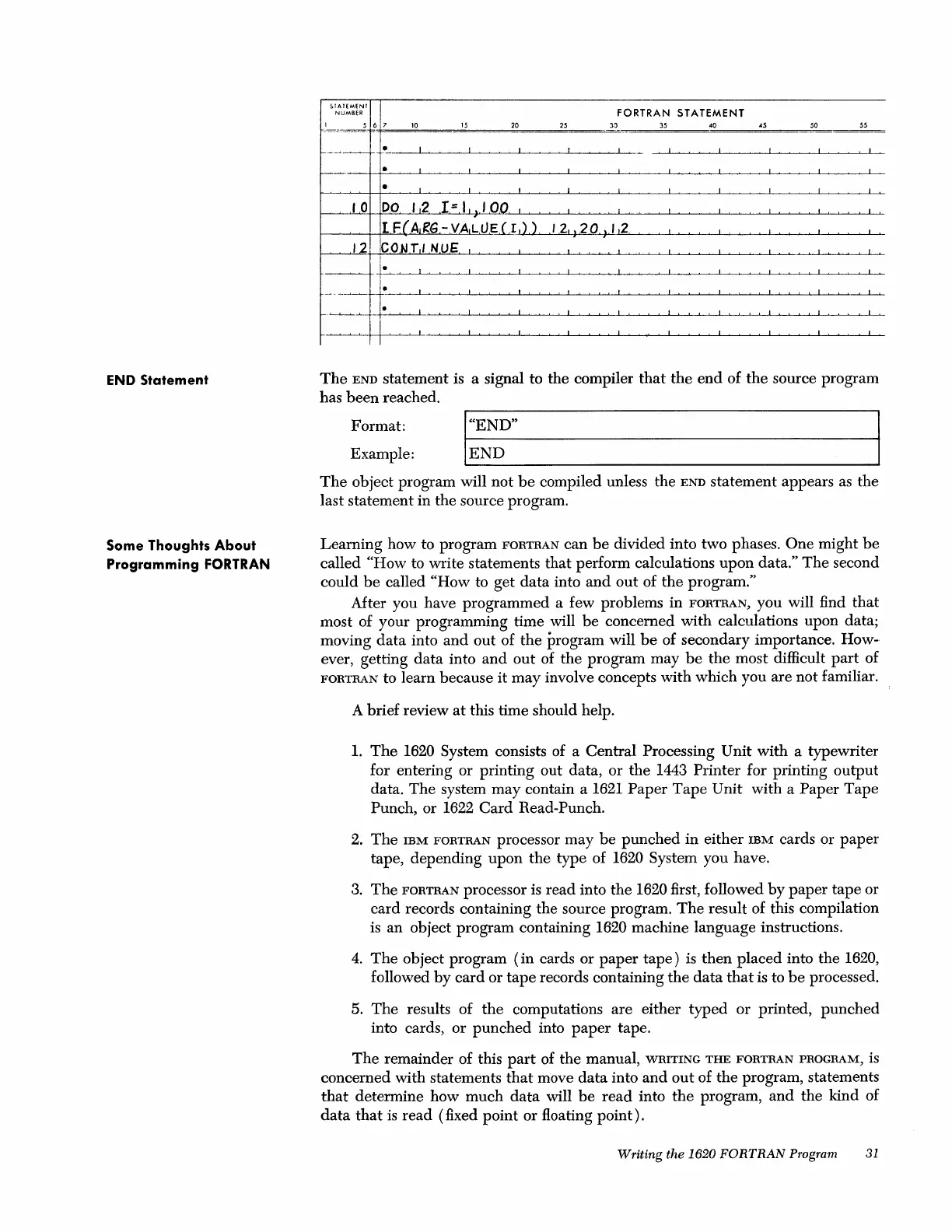END Statement
Some Thoughts About
Programming FORTRAN
51Al£MENI
NUMBER
FORTRAN
STATEMENT
5 6 7
10
15
20 25
30
35
40
45
50
55
--
~-"~
~
~.
•
,
, , ,
•
I
I I I
1
I 0
DO
I
,2
I = I, . J
00
,
I.
F (
AI
~G
-
VA,~
LJ
W.lJ-1
)~)~,
...!o<2L}'
)..!:::2~O~)u..!..I~,2,-,---,-~..L....-~......-L~~...L-...~~~~....L.....
,2
iCON
TIl
NuE
~_~-+.1~~.L.........~......L~~-.L.~~~~~...L.....~~.L......~~L......~~~'---'--......L~~.......L~
~~~:-b~~-'--'~~~~
i
I
The
END
statement is a signal
to
the compiler
that
the
end
of
the
source program
has
been
reached.
Format:
I
"END'
Example:
END
The
object program will
not
be
compiled unless the
END
statement
appears as
the
last statement in the source program.
Learning
how to program
FORTRAN
can
be
divided into two phases.
One
might
be
called
"How
to write statements
that
perform calculations
upon
data."
The
second
could
be
called
"How
to get
data
into
and
out
of
the
program."
After you have
programmed
a few problems
in
FORTRAN,
you will find
that
most of your programming time will
be
concerned
with
calculations upon data;
moving
data
into
and
out
of
the
program will
be
of secondary importance. How-
ever, getting
data
into
and
out
of
the
program may
be
the
most difficult
part
of
FORTRAN
to learn because
it
may
involve concepts
with
which
you are not familiar.
A brief review
at
this time should help.
1.
The
1620 System consists of a Central Processing
Unit
with
a typewriter
for entering or printing
out
data,
or
the
1443
Printer
for printing
output
data.
The
system
may
contain a 1621
Paper
Tape
Unit
with
a
Paper
Tape
Punch,
or
1622
Card
Read-Punch.
2.
The
IBM
FORTRAN
processor
may
be
punched
in either
IBM
cards or
paper
tape, depending
upon
the
type
of 1620 System you have.
3.
The
FORTRAN
processor is
read
into
the
1620 first, followed
by
paper
tape
or
card
records containing
the
source program.
The
result of this compilation
is an object program containing 1620 machine language instructions.
4.
The
object program
(in
cards or
paper
tape)
is
then
placed
into the 1620,
followed
by
card
or
tape
records containing
the
data
that
is to
be
processed.
5.
The
results of
the
computations are either
typed
or
printed,
punched
into cards,
or
punched
into
paper
tape.
The
remainder of this
part
of the manual,
WRITING
THE
FORTRAN
PROGRAM,
is
concerned with statements
that
move
data
into
and
out
of
the
program, statements
that
determine how
much
data
will
be
read
into
the
program,
and
the kind of
data
that
is
read
(fixed
point
or floating
point).
Writing
the
1620
FORTRAN
Program
31
